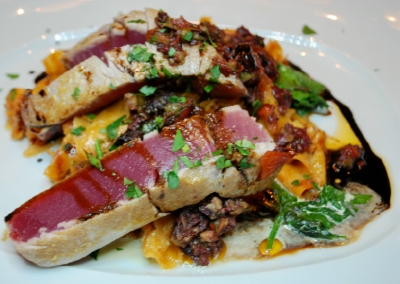
Bluefin Tuna
I'd say the finest moment I've ever had eating tuna fish came about three years ago at the Sake Café Uptown. They'd just bought a substantial lot of fresh Gulf bluefin tuna. Bluefin is the species that you may have heard of selling for thousands of dollars per fish, with the buyers often as not being Japanese.
Bluefin tunas weight hundreds of pounds, with the record being 1500 pounds. Its size puts it at the top of the ocean food chain. It also explains its desirability to man as a food fish. It's a little too desirable, frankly. That explains the high prices. Which, in turn, is evidence of its being overfished. I can't say I can eat bluefin tuna with a perfectly clear conscience. But we don't get many chances to do so.
 Bluefin tuna flesh is an amazing thing to behold. Cut from the best parts, it displays no flake structure at all. It's solid meat, with an amazing silky texture. It's deep maroon in color, with a beautiful bright highlight. The flavor is vivid and wonderful. If you're going to eat bluefin, the only way to go is sashimi. No rice, no searing, none of that. Raw, all by itself.
Bluefin tuna flesh is an amazing thing to behold. Cut from the best parts, it displays no flake structure at all. It's solid meat, with an amazing silky texture. It's deep maroon in color, with a beautiful bright highlight. The flavor is vivid and wonderful. If you're going to eat bluefin, the only way to go is sashimi. No rice, no searing, none of that. Raw, all by itself.
In a side-by-side tasting with the standard yellowfin ("ahi") tuna, I'd say bluefin is better--but not tremendously so.
However, the bluefin tuna I had that magical day at Sake Café was cut from the fatty belly of bluefin tuna (toro). This stuff melts in your mouth, and leaves an amazing creamy sensation. It's hard to believe it comes from the same fish. Even the color is different--an orange hue.
If bluefin tuna ever comes your way, try it. But don't get into the habit of eating it. You won't encounter it often, and I think we maybe ought to put the brakes on its fishery until populations recover. Unfortunately, the Japanese will be hard to convince of that. (They're still whaling, after all.)